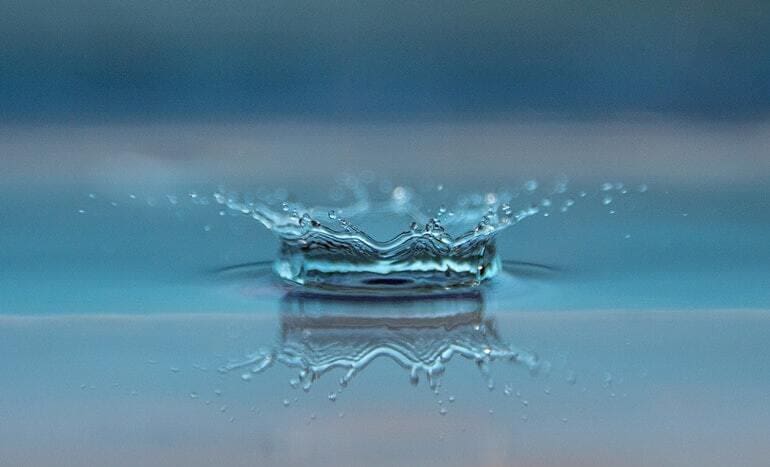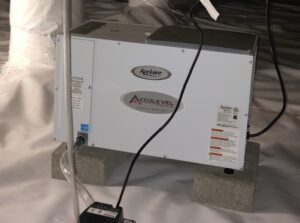Comparing Dehumidifier Types: DIY, Portable, & Whole-Home

Originally posted 5/17/21; updated 12/15/22
Unlike many of you, I’m not a big fan of summer. I don’t like to sweat, there’s way too many insects, and the frizz… I swear my hair doubles in size. But a lot of my dislike is amplified by one factor: humidity. It intensifies the heat of summer, and sticks to the skin. Humidity is what makes our cold drinks condensate and produce water rings on the furniture. Humidity clings to us in the heat, making it feel like we’re all being smothered by a steamy invisible blanket.
But humidity doesn’t just contribute to our discomfort; it also threatens the health and air quality of our homes. Since our start in 1996, Acculevel has helped over 30,000 homeowners in our service area restore strength and stability to their homes. We’re a foundation repair company that specializes in waterproofing basements and crawl spaces. Homes with basements and crawl spaces are particularly vulnerable to humidity and moisture damage.
In this article, we’re going to answer some questions we often hear when customers are fighting with the effects of high humidity: are any of the home remedies for dehumidifying effective? And how do these DIY dehumidifiers compare to portable or whole-home models?
How is Humidity a Threat to My Home?
I mentioned at the beginning that humidity causes our drinks to “sweat” and leave water rings on furniture. Humidity can also produce that condensation in our homes. Have you ever gone into your basement, and noticed that the air felt clammy? Maybe you touched the concrete wall and it felt damp? This moisture alone can be enough of a water source to support biological growth like mold or mildew.
In addition to supporting mold, high humidity can also encourage a variety of bacteria and viruses. A study done by the ASHRAE (American Society of Heating, Refrigerating and Air-Conditioning Engineers) demonstrated that all manner of unpleasant microorganisms thrive in extreme levels of humidity.

For example, let’s say it’s mid-summer and it’s more than 70% humidity in your home. Any virus, bacteria, or allergen that enters your home is going to increase in strength because of the moisture present. This is clearly not good for you or your family.
How Do You Reduce Humidity in Your Home?
You’ve probably heard of dehumidifiers, even if you’ve never bought or used one. But if you haven’t, they’re an appliance that removes moisture from the air. The dehumidifier pulls air in, filters it, cools it, and removes the water from the air. This condensation is then stored in a collection tank which must be emptied regularly.
There are a few options besides this standard, single-room dehumidifier. We’ll review each option, how efficient it is, and the pros & cons of each.
DIY Dehumidifier Options
There are some homeowners who try to avoid buying such a specialized piece of equipment, and decide to improvise their own version. You can easily find these with an internet search engine. They usually involve placing a container of charcoal, rice, baking soda, or even a product like DampRid® in the home. These DIY recipes are meant to passively absorb moisture out of the air.
Do They Work?
Yes, and no. This type of ‘natural’ dehumidifier will collect some moisture from the air. But they won’t remove enough humidity to have any measurable effect on a large room.
These small DIY products are best used in small or enclosed spaces, like a gun safe or a utility closet where your water heater is stored. You can also use a DIY dehumidifier product in your RV or camper when it’s been cleaned and stored for the winter.
DIY dehumidifiers are not efficient or cost-effective for anyone trying to reduce humidity in their home.
Portable Dehumidifiers
These are the appliances I mentioned earlier- a machine that removes moisture from the air. Portable dehumidifiers are easy to operate. You plug it in and turn it on. Some models also have a humidity gauge that allows you to select the humidity level you are trying to achieve.
Pros & Cons
Portable dehumidifiers are relatively effective. They can be noisy to run, which will not be pleasant if you need it in a frequently inhabited area. This is especially important if you’re trying to dehumidify an entire floor of your home. Most portable dehumidifiers can only process a maximum of 50 pints per day, and that’s if they’re running continuously. And any machine that runs non-stop will have a limited life span, forcing you to replace it on a fairly regular basis.
While the sound of the motor is frustrating, the most inconvenient aspect of using a portable dehumidifier has to be emptying the condensation tank. As water is pulled from the air and stored in the condensation tank, the tank eventually fills. At that point, the dehumidifier will stop and (depending on the model) sound an alarm that it needs the tank emptied. You then have to remove the tank, lug it to a kitchen or bathroom, and empty it into a sink. Once the empty tank is replaced, the dehumidifier can begin running again.
Some models do have a drainage line you can attach to the tank. If the line is installed next to a sink or drain, it can be set up to empty the tank automatically. This can also be inconvenient, depending on drain placement and availability.
Whole-House Dehumidifiers
At Acculevel, we recommend that homeowners install a less portable appliance referred to as a whole-home dehumidifier. These are larger than the portable models, and have almost double the processing capacity.
Pros & Cons
A whole-home dehumidifier is the most efficient and effective solution. In a day’s time, a whole-home dehumidifier can remove up to 95 pints. Since this type of dehumidifier is designed specifically to address the humidity pervading your entire home, they’re installed in your basement or crawl space. This means the condensation tank can be routed into your sump pump pit for automatic drainage.
The model Acculevel installs is also warrantied for 5 years, and has an average lifespan of 15 years. Most portable dehumidifiers only have a 1 year manufacturer’s warranty.
The only significant drawback to a whole-home dehumidifier is the initial purchase price. A whole-home dehumidifier costs $2175-2650 (including installation), while a portable dehumidifier is in the $350-600 range. However, if you consider the expected lifespan of the two, the whole-home version is well worth the investment.

This photo was taken by an Acculevel crew member after installing crawl space encapsulation. The dehumidifier condensation line is draining directly into the sump pump.
Additionally, the effectiveness of a whole-home dehumidifier should have a positive impact on your utility bills. Drier air is easier for your HVAC system to process, and lower humidity can often mean you can set your air conditioner at a higher temperature and still be comfortable.
Additional Resources
If you would like to learn more about making your home more comfortable and energy efficient, we have a few other articles that may be helpful for you:
- Do you have fiberglass insulation in your crawl space? Spray foam insulation is a much better option!
- For those of you with a basement, we explain how to bump up the energy efficiency.
- Foundation damage – even small gaps or cracks- can increase your utility bills. We tell you what to look for.
- And for you DIY fans, an excellent way you can protect your foundation is to extend your downspouts. Our blog explains why this is so important to your home, and gives you step-by-step instructions, complete with video demonstration.
Do You Need A Whole-Home Dehumidifier?
You should find a qualified local waterproofing company to evaluate your basement or crawl space. If you live in Indiana or the surrounding areas, call Acculevel! One of our friendly customer care representatives will schedule a free appointment for you. Our knowledgeable project advisors will evaluate your home and provide a written estimate, valid for 12 months.
If you don’t live in our service area, please make sure you verify that your contractor is insured and accredited by the Better Business Bureau.
Not familiar with the process of finding or meeting with a contractor? We offer a free downloadable guide of questions to ask a contractor. This can help you interview and vet companies,to find the best fit for you and your home repairs.